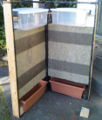
Waterpod™ is a floating sculptural living structure designed as a new habitat for the global warming epoch. It launched in New York July 2009, navigating down the East River, exploring the waters of New York Harbor, and stopping at each of the five boroughs docking at several Manhattan piers on the Hudson River.
Overview[edit | edit source]
As a sustainable, navigable living space, Waterpod™ showcases the critical importance of the environment and serves as a model for new living technologies. It illustrates positive interactions between communities: private and public; artistic and social; aquatic and terrestrial. Built from recycled and reused materials, Waterpod™ is structured as a triple-domed island for: (i) community and artistic activity; (ii) eco-initiatives including food grown with purified water from the Hudson River; and (iii) living space.
The Waterpod was built of wood, metal, plastic, fabric, and other materials on top of an industrial barge. Waterpod™ is structured as a triple-domed island, measuring approximately 120 feet by 40 feet. Construction materials will include salvaged pieces of sunken vessels raised from the river's bottom in the Rockaway and other areas. The main space (27 feet by 50 feet) is an amorphous shape dedicated to community and artistic activity including fine arts, performing arts, lectures, and workshops. Passengers will engage in navigation, mapping, recording, performing, art making, researching, and learning. The second spherical space (20 feet by 20 feet) includes space for hydroponic and vertical agriculture, greywater recycling, and alternative power sources. The third area (10 feet x 20 feet) includes a kitchen and bathroom, and the fourth contains five separate bedrooms. Waterpod™ will rely solely on its own power sources including a vertical wind turbine, solar PV panels, bicycle power, and a pico hydro system, set up to run all equipment on board including rotating art installations and a permanent projector illuminating the Waterpod's dome each night with curatorially selected images.
Waterpod™ showcased artworks, performances, tutorials, discussions, and other creative projects. Open to the public for guided tours, Waterpod™'s course will be logged, blogged, charted, and reported online. Through its dilatory, watery peregrinations, Waterpod™ intends to prepare, inform, inspire, provoke, and fortify humanity for tomorrow's exterior explorations.
Student projects[edit | edit source]
The Spring 2009 semester of ENGR215 Introduction to Design worked with the Waterpod to research, design, and build systems that foster the artists living sustainably onboard the barge.
- Spring 2009 ENGR 215 Intro to Design Projects - Waterpod
-
Bicycle Energy Generator An alternative way to convert kinetic energy to AC power by means of a bicycle energy generator. -
Soil-less Growing System A system that would grow food for the occupants of the barge without the presence of soil. -
Filter Commander 9000 A water filtration system to make drinkable water from rainwater catchment. -
Tour de Volts A bicycle as a power source to provide a bit of extra energy to the Waterpod. -
Waterpod Hang Thyme A hydroponic green wall that is used to grow herbs in minimal amounts of space. -
FBD Rainwater Purification Exists to provide clean drinking water for the Waterpod Project -
Coopatron 5000 A chicken coop designed to supplement the dietary needs of the inhabitants of the Waterpod. -
Rocket Stove To provide a reliable and sustainable means of cooking by minimizing fuel use and optimizing efficiency. -
Pico in a Bucket To harness the kinetic energy of the falling water from the overflow of the Waterpod's water tower. -
WindPod Turbine A vertical access wind turbine that uses the power of the wind coming from any direction to create energy. -
Composting Toilet Duchamp de Loo, is a composting toilet system that can be used and can educate people about environmental ways to get rid of human waste.










